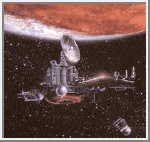 Phobos 1 and 2 to Mars
(JPEG, 29K)
Phobos 1 and 2 to Mars
(JPEG, 29K) Phobos 1 and 2 to Mars
(JPEG, 29K)
Phobos 1 and 2 to Mars
(JPEG, 29K)


Phobos 1, and its companion spacecraft Phobos 2, were the next-generation in the Venera-type planetary missions, succeeding those last used during the Vega 1 and 2 missions to comet P/Halley. The objectives of the Phobos missions were to:
Phobos 1 operated nominally until an expected communications session on 2 September 1988 failed to occur. The failure of controllers to regain contact with the spacecraft was traced to an error in the software uploaded on 29/30 August which had deactivated the attitude thrusters. This resulted in a loss of lock on the Sun, resulting in the spacecraft orienting the solar arrays away from the Sun, thus depleting the batteries.
Phobos 2 operated nominally throughout its cruise and Mars orbital insertion phases, gathering data on the Sun, interplanetary medium, Mars, and Phobos. Contact was lost shortly before the final phase of the mission, during which the spacecraft was to approach within 50 meters (110 feet) of Phobos' surface and release two landers, one a mobile 'hopper', the other a stationary platform. The mission ended when the spacecraft signal failed to be successfully reacquired on 27 March 1989. The cause of the failure was determined to be a malfunction of the on-board computer.

